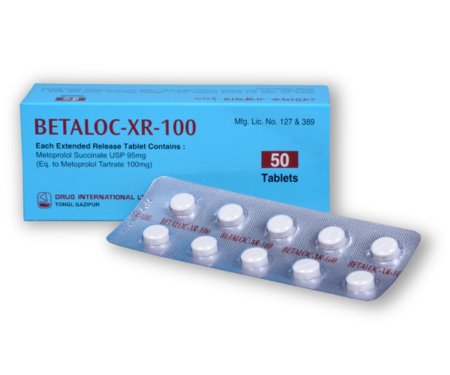
Type:10 Tablets
Generic Name:Metoprolol Tartrate
Manufacturer:Drug International Ltd.
Price:৳60.50
Heart failure, Migraine, Acute MI, Diabetic nephropathy, Hypertension, Cardiac arrhythmias, Angina pectoris
May be taken with or without food.
Oral Hypertension Adult: Conventional tab: Initially, 100 mg/day in single or 2 divided doses, may increase wkly to 400 mg/day depending on response. Maintenance: 100-200 mg/day. Extended-release tab: Initially, 25-100 mg once daily. Angina pectoris Adult: Conventional tab: 50-100 mg bid or tid. Extended release tab: 100 mg once daily. Max: 200 mg once daily. Cardiac arrhythmias Adult: 50 mg bid or tid, may increase to 300 mg/day in divided doses if needed. Adjunct in hyperthyroidism Adult: 25-50 mg 4 times/day. Prophylaxis of migraine Adult: Conventional tab: 100-200 mg/day in divided doses. Extended release tab: 100 mg once daily. Stable symptomatic heart failure Adult: Conventional tab: Initially, 12.5-25 mg once daily, may increase at 2 wk intervals to target dose 200 mg once daily if tolerated. Extended release: 25 mg once daily for 2 wk, 12.5 mg for patient's w/ severe heart failure. Increase at 2 wk intervals to target dose 200 mg once daily if tolerated. Intravenous Emergency treatment of cardiac arrhythmias Adult: Initially, up to 5 mg at a rate of 1-2 mg/min, may repeat at 5-min intervals if needed up to a total dose of 10-15 mg. Prophylaxis or control of arrhythmias on induction of anaesthesia Adult: 2-4 mg as slow inj, may repeat injections of 2 mg as necessary up to max 10 mg. Adjunct in the early management of acute myocardial infarction Adult: Admin w/in 12 hr of the onset of chest pain, 5 mg at 2-min intervals to a total of 15 mg, if tolerated. Patients who have received full IV dose: After 15 min, initiate oral therapy of 50 mg 6 hrly for 2 days. Patients who did not tolerate the full IV dose: Reduced oral dose should be given as and when their condition permits. Subsequent maintenance: 100 mg bid (oral). Patients not given an IV inj: 200 mg in 2 or 4 divided doses started when patient's condition stabilises. Hepatic impairment: Reduce dose. Dosing Considerations In switching from immediate-release to extended-release, same total daily dose of metoprolol should be used In switching between oral and IV dosage forms, equivalent beta-blocking effect is achieved in 2.5:1 (oral-to-IV) ratio
Oral Hypertension Conventional tab: 1-17 years: 1-2 mg/kg/day PO divided BID; not to exceed 6 mg/kg/day or ?200 mg/day Extended-release tab: >6 years: 1 mg/kg PO qDay; not to exceed 50 mg/day initially; adjusted on basis of patient response; not to exceed 2 mg/kg/day or <200 mg/day
Renal impairment: No dosage adjustment needed.
2nd or 3rd degree AV block, sick sinus syndrome, hypotension, decompensated heart failure, sinus bradycardia, severe peripheral arterial circulatory disorders, cardiogenic shock, severe asthma and bronchospasm, untreated phaeochromocytoma, Prinzmetal's angina, metabolic acidosis.
Metoprolol selectively inhibits beta1-adrenergic receptors but has little or no effect on beta2-receptors except in high doses. It does not exhibit membrane stabilising or intrinsic sympathomimetic activity.
Patients w/ myasthenia gravis, well-compensated heart failure, bronchospastic disease, AV conduction disorders, substantial cardiomegaly. May mask signs and symptoms of hyperthyroidism and hypoglycaemia. Patients w/ history of cardiac failure or those w/ minimal cardiac reserve. Patients undergoing major surgery involving general anaesth. Avoid abrupt withdrawal as it may precipitate thyroid storm or MI, and may exacerbate angina and ventricular arrhythmias. Hepatic impairment. Pregnancy and lactation. Patient Counselling May affect ability to drive or operate machinery. Monitoring Parameters Monitor BP, ECG and heart rate. Lactation: Drug is concentrated in breast milk; use with caution (American Academy of Pediatrics states that drug is compatible with nursing)
1-10% Dizziness (10%),Headache (10%),Tiredness (10%),Depression (5%),Diarrhea (5%),.Pruritus (5%),Bradycardia (9%),Rash (5%),Dyspnea (1-3%),Cold extremities (1%),Constipation (1%),Dyspepsia (1%),Heart failure (1%),Hypotension (1%),Nausea (1%),Flatulence (1%),Heartburn (1%),Xerostomia (1%),Wheezing (1%),Bronchospasm (1%) Frequency Not Defined Decreased exercise tolerance,Raynaud phenomenon,Increased triglyceride levels and insulin resistance, decreased high-density lipoprotein (HDL) levels
Additive effect w/ catecholamine-depleting drugs (e.g. reserpine) and MAOIs. May antagonise ?1-adrenergic stimulating effects of sympathomimetics. Additive negative effects on SA or AV nodal conduction w/ cardiac glycosides, nondihydropyridine Ca channel blockers. Paradoxical response to epinephrine may occur. Increased plasma concentrations w/ CYP2D6 inhibitors (e.g. bupropion, cimetidine). Increased risk of hypotension and heart failure w/ myocardial depressant general anaesth (e.g. diethyl ether). Risk of pulmonary HTN w/ vasodilators (e.g. hydralazine) in uraemic patients. Reduced plasma levels w/ rifampicin. May increase negative inotropic and negative dromotropic effect of antiarrhythmic drugs (e.g. quinidine, amiodarone). May reduce antihypertensive efficacy w/ indometacin. May increase effects of hypoglycaemics.